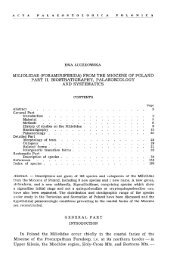The skull of Velociraptor - Acta Palaeontologica Polonica
The skull of Velociraptor - Acta Palaeontologica Polonica
The skull of Velociraptor - Acta Palaeontologica Polonica
You also want an ePaper? Increase the reach of your titles
YUMPU automatically turns print PDFs into web optimized ePapers that Google loves.
ACTA PALAEONTOLOGICA POLONICA (44) (2) 203<br />
slender as in <strong>Velociraptor</strong>, but its contact with the rostrolateral flange <strong>of</strong> the quadrate is<br />
less extensive.<br />
Note that in Ostrom 1969b: fig. 11, the quadratojugal is erroneously oriented and<br />
should be turned about 90" counter-clockwise on fig. 1 la, and clockwise on fig. 1 lb. In<br />
fact, fig. 11 shows the right quadratojugal, not the right reversed as stated in the expla-<br />
nation. <strong>The</strong> process on which the articular surface for the jugal is indicated represents<br />
the ascending process <strong>of</strong> the quadratojugal, and this surface is not for the jugal but for<br />
the contact with the rostrolateral flange <strong>of</strong> the quadrate. Consequently, the process di-<br />
rected upwards on the figure in question is the jugal process <strong>of</strong> the quadratojugal.<br />
<strong>The</strong> nature <strong>of</strong> contact <strong>of</strong> the ascending process <strong>of</strong> the quadratojugal with the<br />
squamosal and quadrate is peculiar in <strong>Velociraptor</strong>, because it looks as if it were not<br />
rigid. Ostrom (1969b: p. 24) has also drawn attention to the fact that in this place the<br />
contact between the two bones 'does not appear to be a particularly solid union', al-<br />
though, due to his erroneous orientation <strong>of</strong> the quadratojugal, he regarded this contact<br />
as the 'clasping junction7 <strong>of</strong> the quadratojugal and jugal. Because <strong>of</strong> the slenderness <strong>of</strong><br />
the ascending process, the paraquadratic foramen is larger in <strong>Velociraptor</strong> than in<br />
Dromaeosaurus (and probably also Deinonychus). As observed by Paul (1988), the<br />
large paraquadratic ('quadrate') foramen is characteristic <strong>of</strong> the Dromaeosauridae. In<br />
most theropods the quadratojugal has a more extensive contact with the quadrate. In<br />
Dromaeosaurus, the end <strong>of</strong> the quadratojugal twists around the quadrate onto its cau-<br />
dal surface, as it does in most theropods. This is not the case in <strong>Velociraptor</strong>. In the<br />
troodontids, the quadratojugal is L-shaped and its ascending process does not reach the<br />
prequadratic process <strong>of</strong> the squamosal (Russell & Dong 1994). In the ornithomirnids,<br />
the quadratojugal, as well as the entire infratemporal region, are not comparable with<br />
those <strong>of</strong> dromaeosaurids. Although the quadratojugal is also slender and reduced in the<br />
oviraptorids, and has a contact with the squamosal, it is rather L-shaped, and its as-<br />
cending process attaches to the caudolateral margin <strong>of</strong> the quadrate, leaving only<br />
a small and caudally facing paraquadratic foramen. <strong>The</strong> contact <strong>of</strong> the quadratojugal<br />
with the quadrate is <strong>of</strong> the cotyla-condyle type in the oviraptorids (Maryafiska &<br />
Osm6lska 1997). <strong>The</strong> jugal <strong>of</strong> <strong>Velociraptor</strong> is similar to those <strong>of</strong> Deinonychus and<br />
Dromaeosaurus. However, in the latter genus, the ventral margin slopes slightly<br />
caudoventrally, and unlike <strong>Velociraptor</strong> does not continue the horizontal line <strong>of</strong> the al-<br />
veolar border <strong>of</strong> the maxilla as does the ventral border <strong>of</strong> the jugal in <strong>Velociraptor</strong> (the<br />
maxilla and jugal are disarticulated in Deinonychus). Presence <strong>of</strong> the jugal pneumatic<br />
recess in Deinonychus has also been reported by Witmer (1997a).<br />
Occiput and braincase<br />
Most <strong>of</strong> the bones forming the occiput and basicranium are fused. <strong>The</strong> occipital condyle is round and<br />
about as wide as the foramen magnum (Figs 2A, 5), although its depth is about a half <strong>of</strong> the vertical di-<br />
ameter <strong>of</strong> the foramen magnum. <strong>The</strong> major part <strong>of</strong> the condyle is formed by the basioccipital. <strong>The</strong> ven-<br />
tral articular surface <strong>of</strong> the condyle is well developed. <strong>The</strong> condylar neck is short. <strong>The</strong> basal tubers are<br />
well separated from each other by a deep broad sulcus. Damage to one <strong>of</strong> the tubers in GIN 100125<br />
shows that the basioccipital is pneumatic. <strong>The</strong> lateral and dorsomedial contacts <strong>of</strong> the supraoccipital<br />
with the parietals is well defined. This bone is roughly subrectangular and abuts dorsally against the<br />
caudal surface <strong>of</strong> the upturned parietals, participating in the formation <strong>of</strong> the central part <strong>of</strong> the trans-<br />
verse nuchal crest. Some distance above the level <strong>of</strong> the foramen magnum the supraoccipital bears<br />
a pair <strong>of</strong> vertical, crescent grooves. <strong>The</strong>y apparently do not lead to any foramen. Sutures between the

















